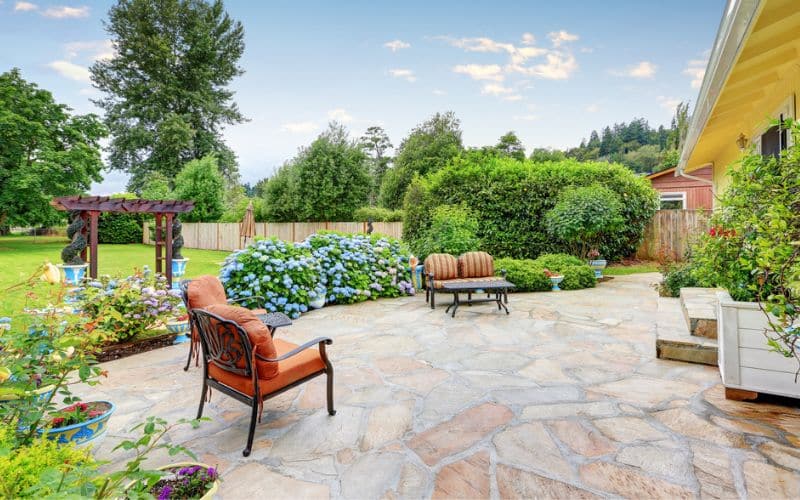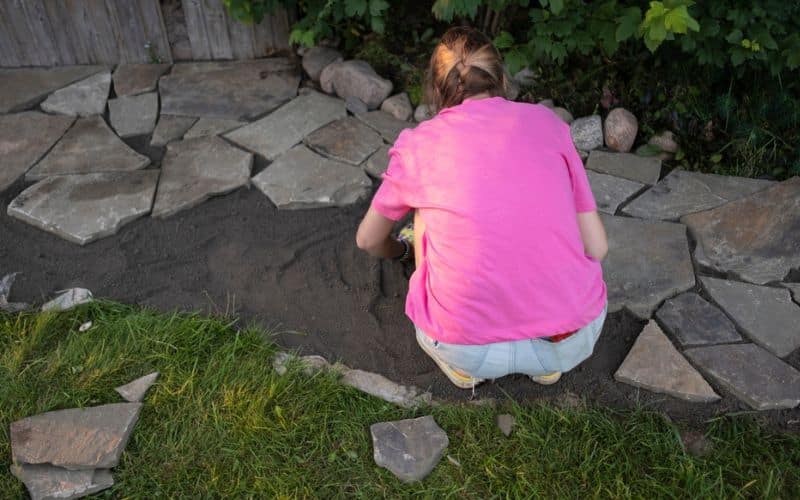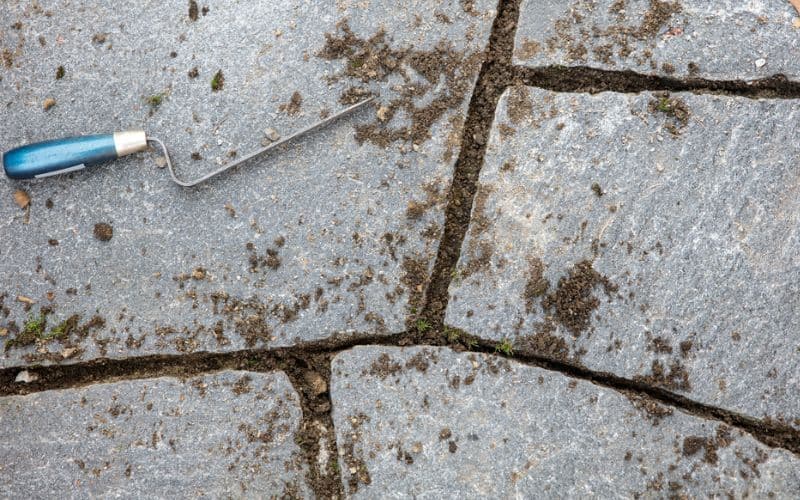
Benefits of a Flagstone Patio
Imagine stepping into your backyard, where a serene flagstone patio awaits, inviting you to unwind and bask in the pleasures of relaxation and entertainment. A well-designed patio has the power to transform your outdoor space into a tranquil oasis, providing a haven for you and your loved ones to enjoy.
One of the main reasons homeowners choose flagstone for their patio is its natural beauty and timeless appeal. With its unique colors and textures, flagstone exudes elegance and charm, effortlessly harmonizing with any landscape. In addition to its aesthetic qualities, flagstone is renowned for its durability and longevity. This natural stone can withstand various weather conditions and heavy foot traffic, making it an excellent choice for a patio that will stand the test of time. Moreover, flagstone requires minimal maintenance, allowing you to spend more time enjoying your patio rather than maintaining it.
Design Considerations
- When designing your flagstone patio, it’s important to consider its shape, size, and layout. Determine the purpose of the patio and how it will fit into your overall outdoor space. Whether you prefer a circular patio for intimate gatherings or a larger rectangular layout for entertaining, choose a design that aligns with your needs and preferences. Incorporating seating areas within your patio design is essential for creating spaces dedicated to relaxation and entertainment.
- Consider adding comfortable seating options such as benches, lounge chairs, or even a cozy hammock where you can unwind and enjoy the outdoors. To add visual interest and create a sense of flow, pathways and focal points can be incorporated. Pathways can guide guests through your outdoor space, while focal points like fire pits or water features provide eye-catching elements that enhance the overall ambiance.
- Harmonizing your flagstone patio with the surrounding landscape is crucial for a cohesive and inviting outdoor environment. Take into account the colors, textures, and overall style of your existing landscape, and select flagstone that complements and enhances the natural beauty of the area.
Material Selection
Flagstone offers a range of options, each with its own unique characteristics. Popular choices include limestone, sandstone, and slate, each offering distinct colors, textures, and durability. Consider your personal preferences, climate, and the overall style you wish to achieve when selecting your flagstone. Factors such as color, texture, and thickness should be taken into consideration when choosing your flagstone. Opt for colors that blend well with your outdoor environment, whether you prefer warm earth tones or cool blues and grays. Texture can range from smooth to rough, so select a texture that aligns with your desired patio aesthetic. The thickness of the flagstone should be chosen based on the expected foot traffic and the stability of the patio. Additionally, you may need additional materials such as gravel, sand, or mortar, which can be used as a base layer for stability and to fill gaps between the flagstone, creating a cohesive surface.

Preparation and Planning
Before embarking on your flagstone patio project, accurately measure and mark the patio area. This will ensure that you have the correct dimensions for materials and help you visualize the layout.
- Clear the space by removing any vegetation, rocks, or debris, and address any obstacles such as tree roots or utility lines that may interfere with the patio’s construction.
- Leveling the ground is essential for a stable and functional patio. Use a leveling tool to ensure an even surface and address any slopes.
- Proper drainage should also be considered to prevent water accumulation on the patio surface. Anticipate potential issues and challenges that may arise during the construction process, such as sloping yards, and plan accordingly by incorporating retaining walls or alternative solutions to ensure a level patio.
Installation Process
To begin the installation process, follow these steps:
Excavation: Start by excavating the area where the patio will be located. Dig down to a suitable depth, usually around 6 to 8 inches, to allow space for the base layer and the flagstone. This ensures that the patio will be at the desired height and level with the surrounding area.
Base Layer: Lay a base layer of gravel or sand over the excavated area. This base layer serves multiple purposes. It provides stability for the patio, helps with drainage to prevent water pooling, and helps to create a level surface. Spread the gravel or sand evenly and compact it thoroughly to ensure a solid foundation.
Flagstone Placement: Carefully place the flagstone on top of the compacted base layer. Consider the desired layout and pattern for your patio and arrange the flagstone accordingly. Leave appropriate spacing between the stones to accommodate expansion joints and allow for easy maintenance. Expansion joints are gaps that allow the flagstone to expand and contract with temperature changes without cracking.
Leveling: Use a level tool to ensure that the flagstone is level and adjust as needed. This step is crucial for creating a flat and even surface. Pay attention to each individual stone and make any necessary adjustments to achieve a uniform level
Filling the Gaps: Once the flagstone is in place and leveled, fill the gaps between the stones. The material you use can be mortar or gravel, depending on your preference and the desired aesthetic of the patio. Mortar provides a more solid and permanent fill, while gravel allows for more flexibility and a natural look. Fill the gaps carefully, making sure the material is evenly distributed and the surface remains level.
Enhancements and Accents
To enhance the ambiance of your flagstone patio, consider the following elements:
Lighting Features
Incorporate lighting elements to create a warm and inviting atmosphere, especially during the evening hours. String lights, lanterns, or solar-powered path lights can be used to illuminate the patio and its surroundings. These features not only provide practical lighting but also add a charming and cozy feel to the space, allowing you to enjoy your patio even after sunset.
Water Elements
Adding water elements such as fountains or ponds can enhance the serenity of your patio. The sound of trickling water creates a soothing and peaceful ambiance, contributing to your relaxation and enjoyment. Depending on the available space and your preferences, you can choose a small tabletop fountain, a larger freestanding fountain, or even a pond with aquatic plants. These water features become focal points and add an element of tranquility to your patio.
Greenery and Landscaping
Integrating plants, shrubs, and trees around your flagstone patio can transform it into a tranquil oasis. Choose plants that complement your outdoor space in terms of color, texture, and size. Consider the climate in your area and select plants that thrive in that environment. Strategically placing potted plants or creating flower beds around the patio can bring life and vibrancy to the area. The greenery softens the hardscape and adds a touch of nature, creating a visually appealing and relaxing atmosphere.

Maintenance Tips
To keep your flagstone patio in excellent condition, it is important to follow these maintenance tips:
Sealing: Consider applying a sealant to your flagstone patio to protect it from stains and moisture. Sealing creates a barrier that helps prevent liquids from penetrating the stone and causing discoloration or damage.
Cleaning: Regular cleaning is crucial to preserve the pristine appearance of your flagstone patio. Use a gentle cleaning solution, such as a mixture of mild soap and water, to remove dirt, grime, and stains. Avoid using harsh chemicals or acidic cleaners as they can damage the stone. Scrub the surface gently with a soft-bristle brush or a mop, and rinse thoroughly with clean water.
Routine Maintenance: Incorporate routine maintenance tasks into your schedule to ensure the long-term durability of your flagstone patio. Sweep the surface regularly to remove leaves, debris, and dirt that can accumulate over time. This prevents the buildup of abrasive particles that can wear down the stone’s surface. Check for any loose or damaged flagstones and address them promptly.
Weed Control: Take measures to prevent weed growth between the flagstone joints. Apply a weed barrier or utilize natural weed control methods, such as manually removing weeds or using environmentally friendly weed killers. Regularly inspect the joints and remove any weeds or plant growth that may have emerged.
Furniture and Decor
When selecting outdoor furniture for your flagstone patio, prioritize comfort and durability.
- Choose materials that can withstand outdoor conditions and opt for cushions and fabrics designed for outdoor use.
- Create comfortable seating areas by arranging furniture strategically, considering the flow of your patio and the available space.
- To add a cozy ambiance, accessorize your patio with cushions, rugs, and outdoor accessories. Soft cushions and rugs can provide additional comfort, while accessories such as lanterns or decorative items contribute to the overall aesthetic.
Conclusion
- Building a flagstone patio offers numerous benefits, including natural beauty, durability, and low maintenance requirements. By following the steps outlined in this guide, you can embark on your own journey to create a tranquil outdoor oasis.
- Remember the importance of design considerations, material selection, and proper installation techniques to ensure a functional and visually appealing patio.
- Embrace the benefits of a serene flagstone patio, where relaxation and entertainment await. Start your project today and enjoy the rewards of your own tranquil outdoor retreat.
Flagstone Patio FAQs
Can I build a flagstone patio myself, or should I hire a professional?
Building a flagstone patio can be a DIY project if you have some experience with landscaping and construction. However, if you are unsure or lack the necessary skills, it’s recommended to hire a professional to ensure proper installation and minimize potential issues.
How long does it take to build a flagstone patio?
The duration of the construction process depends on various factors, such as the size of the patio, the complexity of the design, and the availability of materials. Generally, building a flagstone patio can take several days to a few weeks.
Can I install a flagstone patio on a sloping yard?
Yes, it’s possible to install a flagstone patio on a sloping yard. However, additional steps may be required, such as terracing or incorporating retaining walls to create a level surface.
How often should I seal my flagstone patio?
The frequency of sealing depends on the type of flagstone and the level of foot traffic on your patio. As a general guideline, it’s recommended to seal the flagstone every 1 to 3 years. However, consult with a professional for specific recommendations based on your circumstances.
What are the best plants to enhance my flagstone patio?
When selecting plants for your flagstone patio, choose varieties that thrive in your climate and complement your outdoor aesthetic. Some popular options include lavender, creeping thyme, ornamental grasses, and succulents. Consider factors such as sunlight exposure and water requirements when making your choices.
Colin Macmillan is a seasoned entrepreneur and the CEO of Riverwood Landscape, a leading landscaping company based in Canada. He has been at the helm of the company since leaving high school, demonstrating his strong leadership skills and business acumen.
Colin’s expertise lies in various aspects of landscaping, including lawn care, interlocking, sod installation, and commercial maintenance. His hands-on approach and dedication to the craft have been instrumental in building Riverwood Landscape into a reputable brand.
One of his most notable achievements is the creation of a successful landscape franchise that services multiple locations. This accomplishment underscores his strategic thinking and ability to scale operations effectively.
Colin has also had the privilege of working with Guelph Hospital for landscaping and maintenance, a testament to the trust and reliability that his company has earned over the years.
His professional mission is to offer the best services and experiences for customers, a goal that he tirelessly pursues. Colin’s commitment to excellence and customer satisfaction continues to drive the growth and success of Riverwood Landscape.








